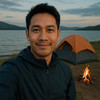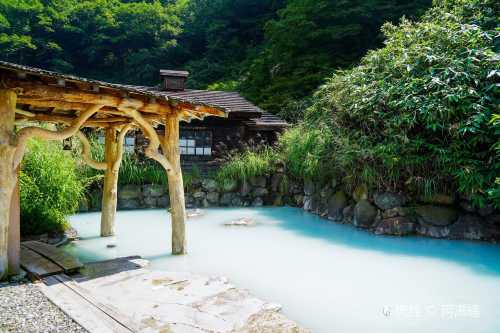Nyuto Onsen – Hot Springs in the Akita Valley – October 20, 2025 In the quiet autumn foliage of northern Japan, a winding path amid fields and fiery foliage leads us to a straw-roofed village that has remained largely unchanged. Old wooden houses, thatched with thatch and stacked timbers, resemble the skin of the mountain itself. Surrounded by tall suzuki trees, the autumn leaves sway in the cool breeze. Akita's autumn is filled with the scent of rain-soaked wood and the hum of forest insects. This village is not just a scene, but a glimpse into the real life of the people of "Yukatamura" (湯治村), or healing villages—where locals use natural hot springs to heal ailments and recuperate from travel. This is Nyuto Onsen (Nyūtō Onsen-kyō), a historic onsen village in Senboku City, Akita Prefecture, comprising seven hot springs. 1. Tsuru-no-yu (Oldest, Milky White) 2. Kuroyu (Dark Gray Water) (Distinctive sulfur smell) 3. Magoroku (Small forest pond with outdoor bath) 4. Ganiba (Streamside pond with a tranquil atmosphere) 5. Taenoyu (Valley view, open to the public) 6. Ogama (Forest hot spring with clear mineral water) 7. Kyukamura (Onsen in a national park lodge) Legend has it that during the Edo period, samurai from the Kuba clan often came to Tsuru-no-yu to heal their ailments. This hot spring was named after the cranes that once stopped to heal their wounds there. People believed that the hot springs from Mount Nyuto were "nature's medicine," healing both body and soul. So, where did we go to capture some photos and enjoy the onsen? Stay tuned for the next episode! 😀 📍 Semboku, Akita Prefecture, Japan Recommended time: October — The red leaves and the hot air converge at their most beautiful. #NyutoOnsen #Akita #JapanAutumn #JapanOnsen #TravelJapan #JapaneseOnsen #onsentrip
Mr. Choon
Popular Trip Moments
First night in the onsen village | From the legend of the crane to the silent well in the valley | Tsuru-no-yu – A place we visit even though we don’t stay | 【Akita】Must-Visit Tourist Spots! | [Akita] Interesting Museum | Lake Tazawa, Japan's deepest lake❤️ | The water was so beautiful that it was so relaxing ❤️ | Snowy Retreat Through Time: A Journey to Tsurunoyu Onsen | Walking through "Little Kyoto of Michinoku" with traces of the Edo period | Tazawako Station: The Gateway to Akita's Scenic Lakes and Mountains | Tazawako Station Forest and Ruins Exhibition Room 🚉🌿 Amazing archaeological discoveries at the station! | Tazawa Lake Lagoji: The legendary beautiful girl "Tatsuko Statue" and the lakeside romance of Ukiki Shrine⛩️🌊 | Tazawako Station Bus Stop: A convenient transfer point! Take the lake bus and easily explore the shores of Lake Tazawa! | Day Trip to Mount Hachimantai | The Beauty of Simplicity—Jōkō-in | Timeless Relics—Kakunodate Historical Village, Aoyagi House. | Hidden in the snow: A century-old secret hot spring|Nyuto Onsen Tsurunoyu | Legend by the Snowy Lakeside|Lake Tazawa & Tatsuko Statue | The Miracle of Snowmelt: Witness the Moment the Dragon Awakens | [Akita] Akita Food Tour Part 2 | [Akita] The best value hot spring resort hotel! | ✨【A unique view at every stop! Tazawako Circle Bus Dream Tour】Every stop is so beautiful that you won't want to leave the bus | Pudding shop in Akita City | [Akita Prefecture] Travel back in time to the quaint town of Kakunodate at the end of summer? | The mysterious and breathtaking view of Dragon Eye | [Akita🇯🇵] Day trip digital detox with Tsuru-no-yu Onsen | [Akita Prefecture🇯🇵] Abandoned schools that are a must-see for Showa retro fans | [Akita Prefecture🇯🇵] The concept is your very own Hachiko story
Recommended Attractions at Popular Destinations
Popular Attractions in Bangkok | Popular Attractions in Kuala Lumpur | Popular Attractions in Dubai | Popular Attractions in Chefchaouene | Popular Attractions in Kyoto | Popular Attractions in Los Angeles | Popular Attractions in Bali | Popular Attractions in Shanghai | Popular Attractions in Iguazu National Park(Argentina) | Popular Attractions in New York | Popular Attractions in Paris | Popular Attractions in Walt Disney World Resort | Popular Attractions in Melbourne | Popular Attractions in London | Popular Attractions in Singapore | Popular Attractions in Beijing | Popular Attractions in Las Vegas | Popular Attractions in Rome | Popular Attractions in Zanzibar Island | Popular Attractions in Sydney | Popular Attractions in West Lake | Popular Attractions in Osaka | Popular Attractions in Tokyo | Popular Attractions in Phuket | Popular Attractions in Barcelona | Popular Attractions in Madrid | Popular Attractions in Chengdu | Popular Attractions in Florence | Popular Attractions in Istanbul | Popular Attractions in Jungfrau Region
Popular Attractions
Shanghai Stadium | Jinjiang Action Park | Lingshan Giant Buddha | Longtouzhu Scenic Area | Soong Ching-ling Memorial Park | Shanghai Wild Animal Park | Tai Hu Yuantouzhu Scenic Spot | Guilin Park | Oriental Pearl Radio & Television Tower | Lion Grove Garden(Shizilin Garden) | North Bridge | Dalian Laohutan Ocean Park | Bingyu Valley | Dalian Haiwang Nine Islands Tourist Area | Slender West Lake | Nationality Museum | National Park of Hainan Tropical Rainforest | Christ Church Melaka | Xian'an Stone Forest | Heath Park | Yüksel Cami | GoGolf Abu Dhabi | Parco giochi | Masjid Al-Falah | Spiaggia di Palude del Conte | Children's Park | 33golflab | Bird Track Springs Camp Ground | Perpustakaan Desa Kampung Kemensah | Big Wild Goose Pagoda
Popular Restaurants in Semboku
Kakunodate Soba | Uchoten Cafe | Ryotei Inaho | Touhachidou | Jingisukan Dining | Fruit Parlor Kakunodate Sakaiya | Kurakichi Kammi Sabo | Teuchi Soba Nonohana An | 櫻丸珈琲 | Sobakiri Chosuke | Morokoshian Kakunodate Ekimae | Dining Michinoku | Tazawako Resthouse | Restaurant Sakura no sato | Tatsuko Chaya | Mizuumi | Nekono Mise Namekawa | Sounds Good | Sakurada Shoten | Sakurakoji | Handmade Soba Sakuragi | Ajisai | Italian Dining Fuga | Cafe Biscuit | Domanin | Inaniwa Koraido Aoyanagike | Petit Phrase | Oguraen | Morokoshian Bukeyashiki | Juwari Soba Restaurant Sobagoro
Popular Ranked Lists
Top 50 Must-Visit Restaurants in Ningbo | Top 10 Luxury Hotels near Thai Binh | Popular Best Things to Do in Qingtongxia | Popular Premium Hotels in Pokolbin | Popular Best Things to Do in Canberra | Popular Premium Hotels in Gwynedd | Top 10 Best Things to Do in Adelaide | Top 50 Must-Visit Restaurants in Koh Samui | Top 10 Best Things to Do in Manila | Top 50 Must-Visit Restaurants in Chaozhou | Popular Premium Hotels in West | Top 50 Best Things to Do in Frankfurt | Top 50 Must-Visit Restaurants in Washington D.C. | Popular Best Things to Do in Amman | Popular Premium Hotels in Whitianga | Top 10 Must-Visit Restaurants in Bad Ischl | Popular Best Things to Do in Addis Ababa | Top 10 Best Things to Do in Minsk | Top 50 Must-Visit Restaurants in Fukuoka | Top 50 Must-Visit Restaurants in Xi'an | Top 10 Best Things to Do in Islamabad | Popular Premium Hotels in Northumberland | Popular Premium Hotels in Llandderfel | Top 50 Luxury Hotels near Mito | Top 10 Best Things to Do in Siem Reap | Popular Premium Hotels in South Lakeland District | Popular Best Things to Do in Xianju | Popular Premium Hotels in Paihia | Popular Best Things to Do in Taipei | Top 20 Best Things to Do in Brisbane
About
Payment methods
Our partners
Copyright © 2025 Trip.com Travel Singapore Pte. Ltd. All rights reserved
Site Operator: Trip.com Travel Singapore Pte. Ltd.
Site Operator: Trip.com Travel Singapore Pte. Ltd.


























